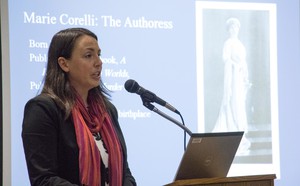Jones discusses 19th century author during lecture

CHADRON – In a recent Graves Lecture, “Corelli’s Designing Fictions: Fashioning the Woman of Genius,” Dr. Mary Clai Jones, assistant professor of English and Humanities at Chadron State College, explored the relationships 19th century English author Marie Corelli’s relationship had with gender roles and biases. Jones spoke in the Sandoz Center’s Chicoine Atrium Tuesday, March 13.
Her lecture featured an article she plans to submit to a scholarly journal in the future. She also plans to eventually include a chapter about Corelli in a book she is writing.
Corelli’s novels sold better than her famous English contemporaries, Arthur Conan Doyle, H. G. Wells and Rudyard Kipling in the late 1880s, and she was a favorite of Queen Victoria’s. Jones said Corelli and her role as an outspoken and provocative woman writer in the male-dominated literary world of her time has only recently become a popular subject for literary scholars.
Jones said Corelli chaffed at the double standard that considered the same characteristics, such as ambition, as a positive trait for men but a negative one for women. Corelli resented the resistance she perceived to feminine boldness.
Corelli argued publicly with the press, accusing it of withholding praise of her work. One female critic, Janet Gallignani, insisted Corelli was only using feminist window dressing but was not a true feminist. Jones said a common insult spat at non-conformist women like Corelli was “unsexed.”
Corelli took solace from harsh critics by basking in adoration from her fans and often referred to herself as a genius.
In Corelli’s “A Romance of Two Worlds,” a lead character, Irene Vassilius, is a wealthy and famous female author, much like Corelli, who uses the phrase “differently constituted,” to describe herself. This phrase may be Corelli's description of herself, as well, Jones said.
Jones said Corelli dealt with celebrity by adopting a carefully curated public persona. For example, Corelli limited the number of photographs and paintings of her face and body. In one case, she provided drawings of three rooms in her home instead of portraits to accompany Jerome K. Jerome’s article in his “My First Book” series about Corelli.
Jones explained how Corelli strategically positioned symbols of expectant art such as a harp, dulcimer and easel in a painting of the drawing room to send a message that she was not in the kitchen or performing domestic duties, but busy doing important, creative work.
A painting of Shakespeare hung on the wall a her home and she mentioned him multiple times in her work.
“It seems like she wanted to reverse the typically gendered roles and have him appear as the muse and she as the genius,” Jones said.
In Corelli’s 1896 novel, “The Murder of Delicia,” Corelli thinly disguises herself as the main character, with the exception that Delicia is married.
Both in describing the star of her novel “Murder of Delicia,” and the sartorial accessories in a famous portrait of herself, Corelli rearranges Victorian symbols such as white lilies, satin, pearls and a star-shaped diamond headpiece to revise their traditional meanings. The satin dress is not a wedding gown and the jewels are not gifts from a male lover or inherited from her family. They were her sole possessions, indicating her economic status and success.
“The diamond on her head is also an accent on her intellect, imitating Greek and Roman icons infused with mystical power,” Jones said. “The overall effect of her clothing and accessories suggests that she is majestic, royal, almost divine. She wanted to be seen as a literary queen. With the train of her gown hiding her feet, as popular in French fashion, she appears to float like a deity.”
Jones expressed appreciation to the audience for their thoughtful comments and questions, and said she may follow up on the insights shared as she continues to write about Corelli.
“There is enough to fill a whole monograph about Corelli alone,” Jones said.
Category: Campus Events, Campus News, English, Graves Lecture Series, Sandoz Society
